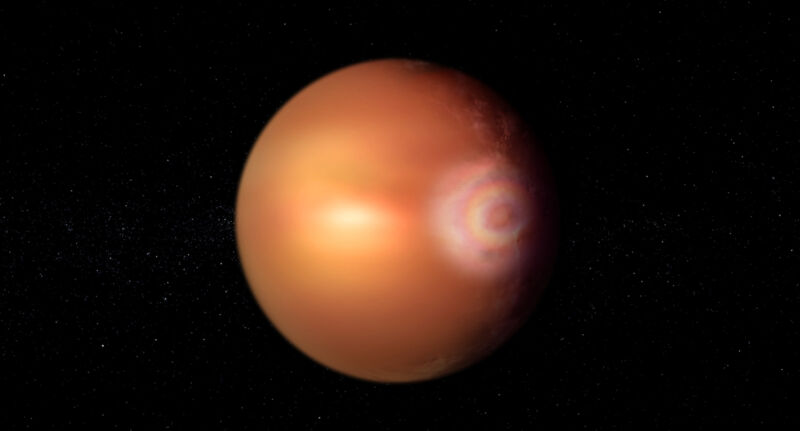Gazing upon a vibrant rainbow arcing across the sky after a refreshing rain shower is a universally cherished experience. But what if this breathtaking display, a testament to the interplay of light and water droplets, could exist on a world far beyond our own?
Recent astronomical observations hint at the tantalizing possibility of a celestial doppelganger – a “glory” adorning the atmosphere of a scorching exoplanet known as WASP-76b.

WASP-76b: A World of Fiery Extremes
Unlike the temperate haven of Earth, WASP-76b is a world forged in fire. This monstrous gas giant, perpetually locked in a tight embrace with its star, endures temperatures exceeding a staggering 2,300 degrees Fahrenheit (1,250 degrees Celsius) – hot enough to melt lead and vaporize most elements. Such scorching heat ushers in a bizarre weather phenomenon – iron rain. The unrelenting dayside heat transforms iron into a vapor, which condenses on the cooler nightside, forming clouds unlike any on Earth – clouds of liquid iron.
An Uneven Glow: A Celestial Enigma
Intriguingly, astronomers have observed a curious asymmetry in WASP-76b’s brightness. The eastern terminator, the boundary separating the dayside bathed in perpetual sunlight from the perpetually shrouded nightside, exhibits an unexpected excess of light compared to the western terminator. This perplexing observation has baffled scientists for some time, prompting a dedicated quest to unravel the underlying cause.
Enter the Glory: A Light Show Born from Liquid Iron
A recent study proposes a captivating solution to the enigmatic light distribution on WASP-76b – a phenomenon called a “glory.” Glories, akin to rainbows, arise when sunlight interacts with uniformly spherical droplets or particles within clouds. The unique atmospheric composition of WASP-76b, with its iron rain and potential liquid iron clouds on the nightside, provides the perfect conditions for a glory to form. Imagine a celestial spectacle unlike any other – a breathtaking halo of color adorning the nightside of an alien world, not due to water droplets, but due to the otherworldly presence of liquid iron clouds.
The Quest for Confirmation: Unveiling the Truth
While the glory explanation is alluring, it remains a hypothesis awaiting definitive proof. Future observations with more powerful telescopes are needed to solidify this theory. If confirmed, this would mark a groundbreaking discovery – the first time a glory has been observed on an exoplanet. Such a confirmation would open a new window into the atmospheric dynamics of these distant worlds, allowing us to peer deeper into the secrets they hold.
Glories: A Keyhole into Alien Atmospheres
The potential existence of glories on exoplanets offers exciting possibilities beyond the spectacle itself. By meticulously analyzing the light reflected from these glories, scientists could potentially glean valuable information about the composition of exoplanetary atmospheres. The specific elements or molecules responsible for the reflected light could provide clues about the presence of water, a potential indicator of habitability. Imagine the wealth of knowledge we could acquire by deciphering the language of light reflected from these otherworldly rainbows!
WASP-76b: A Gateway to Unveiling Celestial Diversity
While the presence of a glory on WASP-76b awaits definitive confirmation, the possibility itself is a captivating testament to the remarkable diversity of celestial phenomena that exist beyond our solar system. The scorching inferno of WASP-76b, with its potential iron rain and liquid iron clouds, serves as a stark reminder that our own Earth, with its water-based life and vibrant rainbows, is a rare and precious gem in the vast cosmic tapestry. Future research holds the key to unlocking the secrets of WASP-76b’s atmosphere and the potential existence of this otherworldly rainbow. The universe continues to unveil its wonders, one celestial spectacle at a time, beckoning us to explore the unimaginable and push the boundaries of our scientific understanding.



















